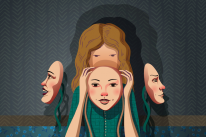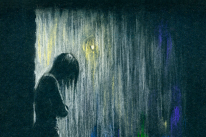
“The intensity of the pain depends on the degree of resistance to the present moment.” ~Eckhart Tolle
Pain can feel like a dark cave with no light to help us find our way out. Or an ocean with waves so big we feel like we can’t ever swim to the shore. Peace is the place we arrive at when we swim to the shore, up and out of the pain we were drowning in. But how do we get there?
For most of us, the first thing we do when we’re in pain is look for somebody to join us so we’re not alone in the darkness of our experience. We hope that by drawing somebody toward us we’ll feel less uncomfortable, like a security blanket that warms and soothes.
It works. They wrap their arms or words around us and we feel more ease, less alone, more protected. We feel like there’s someone there for us.
But it doesn’t take the pain away. I learned this the hard way.
I know I’m not alone in loving love. The high, the affirmation, the cuddles. Not feeling alone anymore. I was what one of my old high school friends once called “a relationshipper.”
Not a dater—someone who casually dated—but someone who went straight from one serious relationship right into the next. I’ll never forget the time one of my well-meaning best friends tried to comfort me post-breakup with the words: “You’ll meet somebody else really soon. You always do.”
That was my wake-up call. I’d been trying to get out of pain by inviting someone else in. It never worked. I just ended up there again.
I finally decided to sit with loneliness, sit with the pain, and not run away from it. Every time I was tempted to call a friend or meet up with someone just to not feel the pain, I didn’t. I sat in it, felt it, cried, got deeply uncomfortable.
And in the process, I got deeply comfortable, too—with being uncomfortable. With being alone. With being on my own. I even got to the point where I was happy. Just me, myself and I. It was okay. It was me.
I feel called to help people in pain. And I was often the one my friends and family called when they were deep in the muck of something terrible. I’d sit and listen, talk soothingly and lovingly, and hope that by the end of the call they’d hang up feeling better—feeling affirmed.
But I didn’t take their pain away. Something else surprising took place—something I only realized recently. What happened was that I affirmed their pain.
Instead of lifting them from it and pulling them to the shore, I affirmed the story their ego was telling them. And the ego is the least peaceful part of us. Always either shrieking to great heights or crashing down to great depths, it’s the part of us that is often terrified.
When I was soothing and listening, I didn’t affirm my friends’ and family’s peace. I affirmed their fear. In a way, I made things worse. Because, although they felt listened to, they hung up without having anything healed. They went on in the same state and space, dragged along up and down by their ego.
When somebody is drowning, we never jump in the water with them. We throw them a life saver and pull them to the shore. When we call a friend and they say, “That’s terrible, you’re right, this is all too much” they climb in the water with us.
There’s a part of us that’s drawn to fear. Our ego and the verbal part of our brain tell us all kinds of stories about what’s terrible or missing. And there’s a part of us that’s drawn to peace: our inner observer is always on-watch, like a lighthouse helping us navigate rough waters.
Somebody who helps us climb out of our pain is much more helpful than somebody who affirms our story. They watch from the place of the observer. And help us get there, too.
Eventually, we get to a place where we can see what we were thinking—the story our ego was telling us—and see that it was a painful version of events. We get to a place of peace. We arrive on the shore, healed.
What if you don’t have a friend who can be at peace and help you get there, too?
Try this.
1. Write down all the thoughts you’re thinking about the situation.
For me, in the pain after a breakup, it was always “I’ll never meet someone.” And “I’ll always be alone.”
2. Then imagine they came from somebody else, that this is a version of events being told by a playwright.
It is—the playwright is your ego.
I imagined a sad, scared version of me, not seeing the whole picture, caught up in fear. Stuck in a room when there was an entire world to explore. Missing it all.
3. Ask yourself if this version of events is bringing you into the power of peace or pulling you out of it.
If it’s pulling you out of it, it’s not serving you. It’s making things worse.
Q: Is this version of events—I’ll never meet someone and I’ll always be alone—pulling me out of peace or bringing me into the power of peace? A: Definitely out of it.
4. Write another version of the situation—a more peaceful one.
It can be the opposite of the first one. Arrive in the place of the observer and the creator.
For me: My different version of the original story lead to: “I’ll meet someone and I’ll never be alone,” which lead to something even greater: “I’m meeting someone right now—myself. And, I’m never alone.” This is a much more peaceful version, and one I could only see when I lifted up out of fear.
Slowly but surely, begin your practice of befriending your ego instead of letting it master you, and stepping out of fear.
Eventually, you’ll arrive at that shore. And know that the next time, you can do it again.
Photo by McBeth Photography
About Lindsey Lewis
As a successful magazine editor, Lindsey Lewis realized her whole life didn’t fit her. She promptly had a quarter life crisis and blew up her entire life. You can read her story in her book From Darkness to Light. Find her at imlindseylewis.com, on Facebook and Twitter @lindsey_lewis.













 Though I run this site, it is not mine. It's ours. It's not about me. It's about us. Your stories and your wisdom are just as meaningful as mine.
Though I run this site, it is not mine. It's ours. It's not about me. It's about us. Your stories and your wisdom are just as meaningful as mine. 